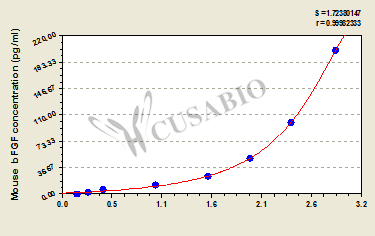CUSABIO's bFGF mouse ELISA kit is an in vitro enzyme-linked immunosorbent assay for the quantitative measurement of mouse bFGF in serum, plasma, cell culture supernates, or tissue homogenates. This assay uses an antibody specific for mouse bFGF coated on a 96-well plate. bFGF present in a sample is bound to the wells by the immobilized antibody after adding the sample into the wells. Biotinylated bFGF antibody is added to the wells, forming an antibody-analyte-antibody complex. HRP-conjugated avidin is pipetted to the wells and binds to the complex. A TMB substrate solution is added to the wells and color develops in proportion to the amount of bFGF bound. The addition of Stop Solution changes the color from blue to yellow, and the intensity of the color is measured at 450 nm using a microplate reader.
bFGF, also called FGF2, is a powerful angiogenic molecule that stimulates smooth muscle cell growth, wound healing, and tissue repair. In addition, FGF2 may stimulate hematopoiesis and may play an important role in the differentiation and/or function of the nervous system, eyes, and skeleton. Together with heparin or heparin sulfate proteoglycan, FGF2 activates FGFRs, inducing its pleiotropic effects in different tissues and organs, including potent angiogenic effects and important roles in the differentiation and function of the central nervous system (CNS). FGF2 plays a critical role in the development of the CNS. FGF2/FGFR1 signaling has been a hotspot of therapeutic development for neurodegenerative diseases such as multiple sclerosis, Alzheimer’s disease, and Parkinson’s disease.






